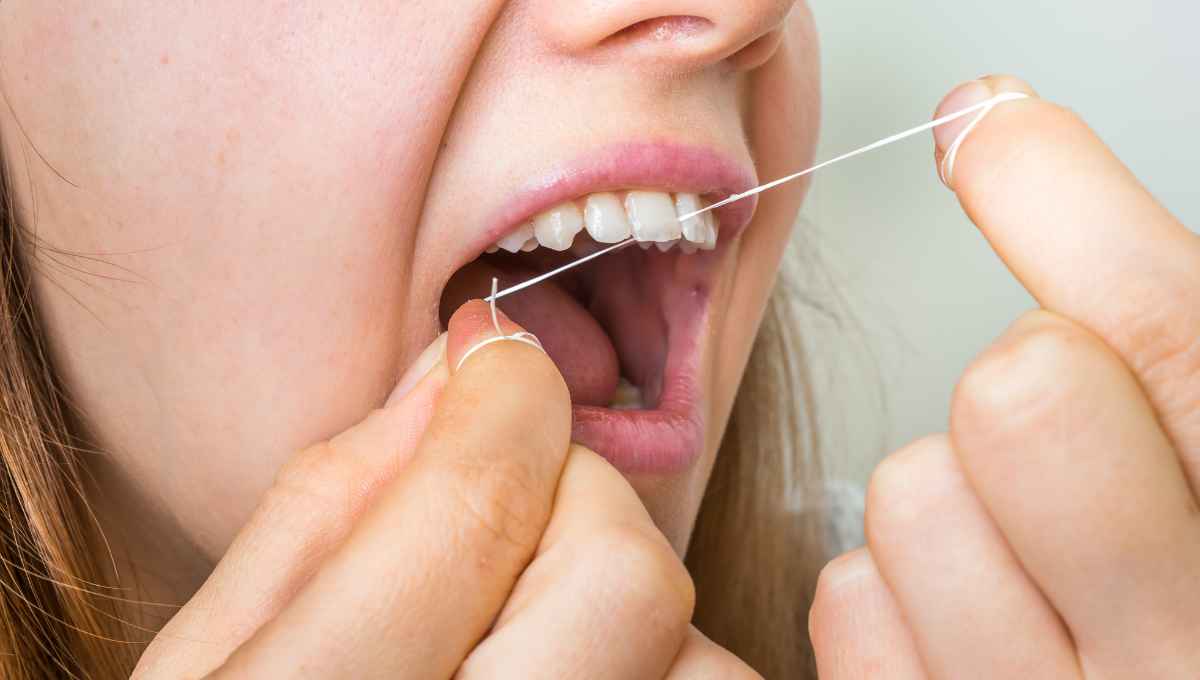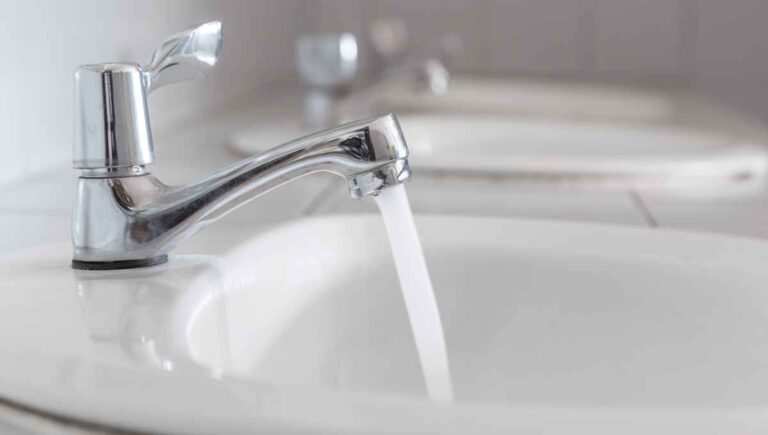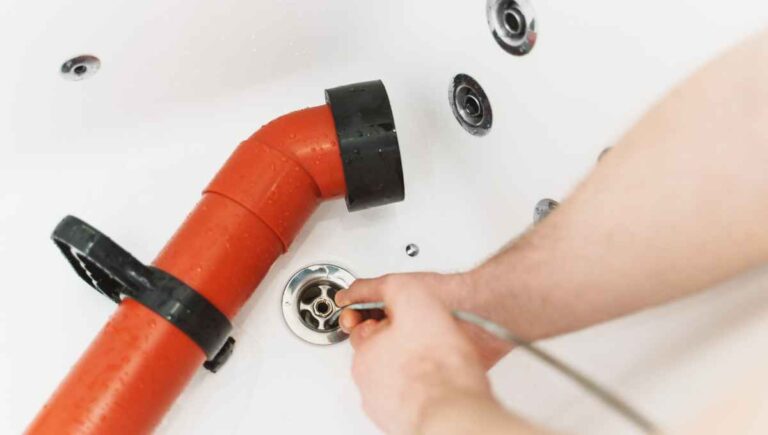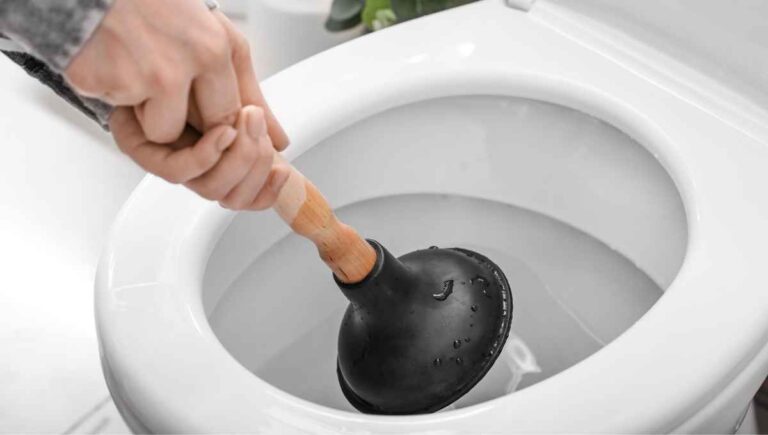Can You Flush Dental Floss Down the Toilet? (Don’t Try This)

When it comes to personal hygiene, dental care is a crucial aspect that most people tend to overlook. While brushing and flossing are essential for maintaining healthy teeth and gums, disposing of used floss can be a bit of a conundrum. Can you simply flush it down the toilet like toilet paper, or is that a recipe for disaster?
Dental floss is not biodegradable and can cause serious problems for your plumbing system if flushed down the toilet. It can wrap around pipes and create blockages that can result in expensive repairs. In short, it’s never a good idea to flush dental floss down the toilet.
But if flushing dental floss is not an option, what alternatives are there? We’ll explore some easy and eco-friendly ways to dispose of your used dental floss that won’t harm your plumbing or the environment. Keep reading to find out more!
This post contains affiliate links. This means Household Blogger may earn a commission should you make a purchase using any of our links. Please refer to our full affiliate disclosure policy for full details.
Here’s a Quick Pro Tip!
Here are some reusable dental flossers you can purchase on Amazon:
1. Waterpik Cordless Water Flosser – A convenient and portable option for on-the-go flossing.
2. GUM Soft-Picks – A gentle and effective way to remove plaque and food particles from between teeth.
3. Dental Floss Picks with Threader – These floss picks come with a built-in threader to help you get the floss between tightly spaced teeth.
Why Flushing Dental Floss Down the Toilet Is Not Recommended
In this section, we will discuss why flushing dental floss down the toilet is not a good idea and the potential consequences it can have on our plumbing systems and the environment. So, let’s dive in!
Dental Floss and Plumbing Problems
The convenience of flushing dental floss down the toilet is appealing, but it can cause significant plumbing problems that can lead to costly repairs.
Dental floss can get caught on pipes and other plumbing fixtures when flushed down the toilet. Over time, as more floss is flushed down, it can start to accumulate and form a clog.
One of the most significant issues caused by dental floss in plumbing is that it can wrap around other debris and create a stubborn clog that is difficult to remove. When the floss accumulates and becomes tangled with other materials in the pipes, it can create a mass that can completely block the flow of water.
This can cause water to back up in the pipes and create a major plumbing issue. Another problem that can arise from flushing dental floss down the toilet is that it can cause costly repairs.
If the floss creates a clog that cannot be easily removed, a plumber may need to be called in to fix the problem. This can result in a hefty bill, as the plumber may need to use specialized equipment or spend hours disassembling the plumbing to access the clog.
In addition to the potential for clogs and costly repairs, flushing dental floss down the toilet can also harm the environment. Floss is not biodegradable and can take years to break down in the water. This means that it can accumulate in waterways and harm wildlife that may mistake it for food.
Environmental Impact of Flushing Dental Floss
Flushing dental floss down the toilet can significantly impact the environment. Floss is made from synthetic materials that are not biodegradable, meaning they do not break down naturally in the environment.
As a result, when floss is flushed down the toilet, it can accumulate in waterways and cause harm to the environment.
One of the most significant environmental impacts of flushing dental floss down the toilet is its impact on water quality. Floss can get caught in pipes and plumbing fixtures and accumulate in waterways, leading to pollution.
Over time, this can lead to a buildup of contaminants in the water, which can be harmful to wildlife and humans who depend on the water for drinking or recreation.
In addition to its impact on water quality, flushing dental floss down the toilet can also harm wildlife. Wildlife, such as fish and birds, can mistake floss for food and ingest it, leading to digestive problems and potential death.
Even if wild animals do not ingest the floss directly, it can still harm them by tangling around their limbs or beaks, causing injury or restricting their movement.
Furthermore, flushing dental floss can also have an impact on wastewater treatment facilities. Floss can clog up pumps and other equipment at these facilities, causing equipment failure and requiring costly repairs.
This can also result in the release of untreated wastewater into the environment, which can further harm water quality and wildlife.
Municipal Regulations and Dental Floss
Many cities and municipalities have regulations in place that prohibit the flushing of dental floss down the toilet. These regulations are put in place to protect plumbing and water systems from damage and prevent environmental harm. Violating these regulations can result in fines or penalties.
For example, the city of San Francisco has banned the flushing of floss down the toilet as part of its efforts to reduce waste and protect the environment. Other cities, such as New York and Chicago, also have similar regulations that prohibit flushing floss down the toilet.
Penalties for violating these regulations can vary depending on the city or municipality. In some cases, violators may receive a warning for their first offense, while in others, they may be subject to fines or even legal action.
In addition to fines or penalties, violators may also be required to pay for any damages caused by flushing floss down the toilet.
It is important to note that these regulations are put in place for a reason, and violating them can have significant consequences. By disposing of dental floss in the trash instead of flushing it down the toilet, individuals can help protect the environment and avoid potential fines or penalties.
Alternatives to Flushing Dental Floss Down the Toilet
While dental floss is essential in maintaining good oral hygiene, flushing it down the toilet can cause serious problems for your plumbing and the environment.
Fortunately, alternative ways to dispose of dental floss are safe and environmentally friendly. This section will explore some of the best alternatives to flushing dental floss down the toilet.
Disposing of Dental Floss in the Trash
When it comes to disposing of dental floss, throwing it in the trash is the best option. Floss is not designed to be flushed down the toilet, even if it’s biodegradable. Flushing dental floss can cause blockages in your home’s plumbing system or even in the city’s sewer lines.
When you’re ready to throw away your used dental floss, it’s important to wrap it in tissue or paper before putting it in the trash can. This prevents the floss from getting tangled in the trash and ensures that it won’t become a hazard for people handling the garbage.
It’s also important to note that dental floss should never be flushed down the toilet, even if it’s labeled as “flushable” or “biodegradable.” These labels can be misleading, as dental floss does not break down easily in water and can cause serious clogs in your plumbing or sewage system.
To summarize, always dispose of your dental floss in the trash by wrapping it in tissue or paper before throwing it away. Avoid flushing floss down the toilet, even if it’s labeled as “flushable” or “biodegradable,” to prevent potential plumbing problems.
You might also enjoy our post on Whether You Should Flush Food Down The Toilet
Recycling Dental Floss
While it’s best to dispose of dental floss in the trash, some companies have started recycling floss into eco-friendly products. This is a great way to reduce waste and give used floss a new life.
If you’re interested in recycling your dental floss, check with local recycling facilities to see if they accept it. Some facilities may have specific guidelines or policies on how to properly recycle dental floss, while others may not accept them at all.
It’s also worth noting that not all types of dental floss can be recycled. Flosses made from materials like nylon and Teflon may not be recyclable, while natural fibers like silk or bamboo may be more eco-friendly options for recycling.
If you’re unable to find a recycling facility that accepts dental floss, consider looking for eco-friendly dental floss options instead. Some brands offer biodegradable floss made from natural materials that can be safely composted, reducing waste and environmental impact.
Using Reusable Dental Floss
Another eco-friendly option for dental floss is to use reusable floss. Reusable dental floss is designed to be washed and reused multiple times, reducing waste and environmental impact.
Reusable dental floss is available in several materials, including bamboo and silk. These materials are biodegradable and eco-friendly, making them a great choice for those looking to reduce their environmental footprint.
To use reusable dental floss, simply rinse it off after each use and store it in a clean container. When the floss becomes worn or frayed, it can be washed and reused multiple times before needing to be replaced.
Using reusable dental floss is a great way to reduce waste and make a positive impact on the environment. By choosing biodegradable materials like bamboo and silk, you can ensure that your dental care routine is not only good for your teeth but also for the planet.
The Proper Way to Dispose of Dental Floss
Dental floss is an essential tool for maintaining good oral hygiene, but disposing of it properly can sometimes be confusing. Many people wonder if they can simply flush it down the toilet, but is that the correct method of disposal?
In this section, we will explore the proper way to dispose of dental floss and why flushing it down the toilet may not be the best option.
Wrapping Dental Floss Before Disposal
When it comes to disposing of dental floss, it’s essential to wrap it properly before throwing it away. Doing so will help prevent contamination and tangling, which can cause problems in your plumbing system.
One way to wrap dental floss is to use tissue or paper. Simply take a small piece of tissue or paper and wrap the used floss around it before throwing it in the trash. This will help keep the floss contained and prevent it from tangling with other items in your trash bin.
Another benefit of wrapping dental floss before disposal is that it can help prevent contamination. When dental floss is left exposed, it can come into contact with other items in the trash, such as food waste or other debris. This can create a breeding ground for bacteria, which can lead to unpleasant odors and even the spread of germs.
By wrapping your used dental floss in tissue or paper, you can help keep it separated from other items in your trash bin and prevent the spread of bacteria. It’s a simple step that can go a long way toward keeping your home clean and healthy.
So, make sure to wrap your dental floss before disposal, and you’ll be doing your part to keep your plumbing system and the environment in good condition.
Disposing of Dental Floss in a Biodegradable Manner
If you’re concerned about the environmental impact of dental floss, you’ll be pleased to know that some brands offer biodegradable options. These flosses are made from materials that break down naturally over time, which can be a more eco-friendly option than traditional dental floss.
The process of disposing of biodegradable dental floss is similar to that of regular floss. Simply throw it away in the trash, but make sure to wrap it in tissue or paper first, as we discussed in the previous section. This will help prevent tangling and contamination and ensure that the floss is contained in the trash bin.
If you’re someone who composts, you might be wondering if you can add biodegradable dental floss to your compost pile. The answer is yes, but with a caveat. Biodegradable floss is typically made from materials like silk or cornstarch, which can break down in a compost pile.
However, it’s important to note that not all composting systems are designed to handle materials like dental floss. Before adding biodegradable dental floss to your compost, check with your local composting facility to ensure that it’s a suitable material.
Guidelines for Disposing of Dental Floss
When it comes to disposing of dental floss, it’s important to follow local guidelines for proper disposal. Different areas may have different regulations regarding what can and cannot be disposed of in the trash or compost.
It’s always a good idea to check with your local waste management company to ensure that you’re following the proper procedures for disposal.
In addition to checking with local waste management companies, you can also check with local recycling facilities to see if they accept dental floss. Some facilities may be able to recycle biodegradable floss or floss made from certain materials.
It’s also important to note that dental floss should never be flushed down the toilet. Dental floss is not biodegradable and can cause serious problems for your plumbing system and the environment.
By following proper guidelines for disposing of dental floss, you can help ensure that you’re doing your part to keep your home and the environment healthy. So, check with local waste management companies and recycling facilities for additional information on how to properly dispose of dental floss in your area.
You might also enjoy our post on Whether Comet Cleaner is Toxic
The Impact of Dental Floss on the Environment
In this section, we will delve into the environmental impact of dental floss and how it affects our planet. We will examine the issues surrounding the disposal of dental floss, including the potential harm it can cause to our waterways and wildlife.
Additionally, we will explore alternative solutions for maintaining oral hygiene that is more eco-friendly.
Dental Floss and Microplastics
In this section, we will discuss how traditional floss can contain harmful plastics, leading to the clogging of plumbing systems, and how the use of dental floss contributes to the proliferation of microplastics that can harm the environment and wildlife.
Firstly, flushing dental floss down the toilet can cause significant plumbing problems. Traditional dental floss is made of nylon, which is a type of plastic. When flushed down the toilet, dental floss can easily become entangled with other waste, clogging pipes and sewer systems.
This can be especially problematic in older plumbing systems that are not equipped to handle such waste.
Moreover, traditional dental floss can contain harmful plastics that can have a negative impact on the environment. Studies have shown that some brands of dental floss contain polytetrafluoroethylene (PTFE), a type of plastic that is often used in non-stick cookware.
PTFE has been linked to a variety of health problems, including cancer and reproductive issues. When flushed down the toilet, these plastic materials can break down into smaller particles, known as microplastics, which can enter the water supply and harm the environment.
Microplastics are small plastic particles that are less than 5 millimeters in size. These particles can be harmful to both the environment and wildlife.
When they enter the water supply, they can be ingested by marine animals, such as fish and birds, which can cause various health problems, including damage to their digestive systems. Additionally, microplastics can accumulate in the food chain, potentially causing harm to humans who consume seafood.
Dental Floss and Water Pollution
Dental floss is common in waterways and can contribute to water pollution. When flushed down the toilet or disposed of improperly, floss can end up in rivers, lakes, and oceans, harming aquatic ecosystems.
Floss is made of nylon or other synthetic materials, which are not biodegradable. Floss can persist for years when it enters the waterways, and wildlife may ingest it or become entangled, causing harm or death. Additionally, floss can absorb pollutants and toxins from the water, which marine animals can then ingest.
Furthermore, when floss is disposed of in landfills, it can lead to harmful chemicals leaching into the surrounding soil and groundwater. These chemicals can harm both humans and wildlife that come into contact with them.
It’s important to dispose of dental floss properly and not flush it down the toilet. Throwing it in the trash can be sent to a landfill where it will not contribute to water pollution. Alternatively, some brands of eco-friendly dental floss are available that are made from natural materials that are biodegradable and won’t harm the environment.
Sustainable Alternatives to Traditional Dental Floss
Traditional dental floss is often made of nylon, which is not biodegradable and can contribute to pollution in the environment. Fortunately, sustainable alternatives to traditional dental floss are better for the environment.
One eco-friendly alternative is bamboo floss. Bamboo is a fast-growing and sustainable material that is biodegradable and compostable. Bamboo floss is often coated with natural wax and infused with essential oils, providing an effective cleaning experience that is also gentle on teeth and gums.
Another sustainable alternative is silk floss. Silk is a natural material that is biodegradable and compostable. Silk floss is often coated with natural wax and infused with essential oils, providing an effective cleaning experience that is gentle on teeth and gums.
Other eco-friendly options include floss made from natural fibers such as cotton or plant-based materials such as cornstarch. These materials are biodegradable and can be composted, reducing their impact on the environment.
In addition to these sustainable alternatives, some brands also offer refillable floss dispensers to minimize waste. By refilling the dispenser with eco-friendly floss, consumers can reduce their environmental impact while still maintaining good oral hygiene.
Final Thoughts
While it may be tempting to flush dental floss down the toilet for the sake of convenience, it is not a good idea. Dental floss is not biodegradable and can cause blockages in your plumbing or sewer system. Furthermore, flushing floss can harm the environment by contributing to pollution in our waterways.
Instead of flushing dental floss, it’s important to dispose of it properly by throwing it in the trash. By taking this small step, we can help to protect our plumbing, the environment, and ultimately, our health. So, next time you finish flossing, remember to toss your floss in the trash can rather than flushing it down the toilet.








